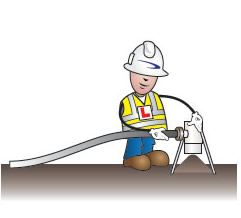
A Practical Guide to Screed Testing: What Do the Experts Say?

A Practical Guide to Screed Testing: What Do the Experts Say?
Ready-Mix Screed or Site-Mixed Screed - the better option?
 With screed failure becoming a widespread issue in the UK, contractors and builders are more cautious than ever when it comes to choosing their screed. Is ready-mixed screed – the screed batched and mixed in the factory and delivered to site – the safer option, or is it safer to rely on the expertise of a skilled screeder and allow the screed to be mixed as required, on site? The Screed Scientist examines.
With screed failure becoming a widespread issue in the UK, contractors and builders are more cautious than ever when it comes to choosing their screed. Is ready-mixed screed – the screed batched and mixed in the factory and delivered to site – the safer option, or is it safer to rely on the expertise of a skilled screeder and allow the screed to be mixed as required, on site? The Screed Scientist examines.
Ready-mix Screeds
The Advantages:
- Convenience: Ready mix screed can be a convenient option as the screed is batched and mixed in the factory following stringent quality procedures, and delivered to site on a tipper truck.
- Quality Control: The screed mix is produced in compliance with European Standards BS EN13813, and subjected to a string of quality checks before it leaves the factory gate.
The Disadvantages:
- Price: Ready-mix screeds are typically more expensive than site-mixed screeds.
- Lack of flexibility: Ready-mix screeds come with retardants to prevent the screed mix from setting or hardening for a fixed number of hours. But any unexpected delays longer than that – en route or at the site – can render entire batches of screed unusable.
Errors in initial assessment of screed depth or material quantities can be more difficult to resolve, as it would mean unexpected requirement of additional loads of screed. It can be difficult to procure additional batches of screed on short notice and get it delivered to site in time.
- Wastage: Higher amount of wastage and landfill compared to site-mixed screeds.
- Workmanship: Ready-mix screeds are not always laid by specialist screeders. Due to the premium cost and limited flexibility in accommodating plan changes, specialist screeders mostly prefer to use site-mixing over ready-mixed screeds. Ready-mixed screeds are usually installed by ready-mix plant operatives who do not often have the same high levels of training or specialist mixing machinery as specialist screeders. The involvement of the screeder in the design and planning phases are crucial to achieve the expected quality standards for the installed screed.
Site-Mixed Screeds
The Advantages:
- Flexibility: Screeds are mixed directly at the site, as per requirement. This allows more room to accommodate plan changes, without causing significant changes in budget. It also allows the use of screed accelerators and additives as required. Mixing the screed on site as per requirementminimizes wastage and landfill, and also helps to cut down the carbon footprint.
- Pricing: The pricing is more competitive compare to ready-mixed screeds, as it does not include the premium for mixing at the factory and delivering to site. As site mixing allows more flexibility to accommodate plan changes, the control over unexpected expenses is higher.
- Skilled workmanship: Site mixing is mostly preferred over ready-mixed screeds by specialist contractors due to higher flexibility and better control over expenses. Using force action mixers or screed pumps can help to produce the same quality screed mix as that produced in a factory, provided stringent quality control measures are followed at the site.
The Disadvantages:
Quality assessment of the screed mix: The current European Standards do not cover all site-mixed screeds, as the accuracy in batching and mixing and can vary for site-mixed screeds, depending on the skill and expertise of the screeder.
Controlling the quality of the screed: Quality management is totally reliant on the screeder or screeding contractor.
The Screed Scientist Verdict:
 Both ready-mix and site-mixed screeds have their own host of positives and negatives. Ready-mixed screeds are priced at a premium. But they can provide value if the screeding is carried out by professional, skilled screeders who are involved in the planning process right from the design stage.
Both ready-mix and site-mixed screeds have their own host of positives and negatives. Ready-mixed screeds are priced at a premium. But they can provide value if the screeding is carried out by professional, skilled screeders who are involved in the planning process right from the design stage.
For site mixed screeds, the major advantages are lesser costs, greater flexibility and minimal wastage. But the quality relies mostly on the expertise of the screeding contractor, as the chances of manual error are higher for site mixed screed. However, if the screed mixing is undertaken by skilled screeders, it is possible to produce the same quality screed-mix on site, as ready-mix – but with the added advantages of cheaper costs, lesser wastage and better expertise in the installation of the screed.
Whichever the choice, the crucial factor in determining the final success of the screed is – choosing the right hands for the job!





